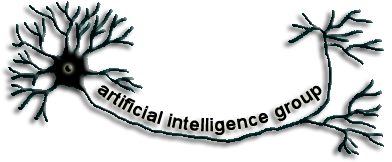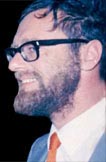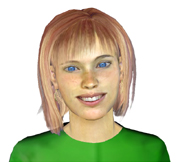
Computer Science Department - The University of Auckland
The goal of this page is to keep a current list of projects of the Artificial Intelligence (A.I.) Group. Members of the A.I. Group are lecturers, PhD and MSc students of the Computer Science Department of the University of Auckland. For a complete listing and many other A.I. papers, refer to the below web site of the Department of Computer Science.
Computer Science Department
Some of the research and development work related to the software Robot referred to in this page was conducted with support from the Centre of Digital Enterprise (CODE), which is a section of the Information Systems and Operational Management (ISOM) department at the University of Auckland.
Information Systems Departmentome
List of some of activities of AI Group
 AIG has a strong connection with the software engineering group, computer graphics group, robotics group of Tamaki campus and the theoretical, mathematical group.
AIG has a strong connection with the software engineering group, computer graphics group, robotics group of Tamaki campus and the theoretical, mathematical group.
 What AIG does is to try and narrow down the line between biological carbon-based intelligence and silicon-based computational intelligence. In general, AI algorithms can be divided into two groups: (1) quantitative computational methods such as neural networks, and case-based reasoning algorithms and (2) logical methods such as decision trees and inferencing algorithms. This leads to inventing and implementing new computational, mathematical and logical algorithms that bring us nearer to the dream of creating a real Mr Data of Star Trek with a balanced emotion chip attached.
What AIG does is to try and narrow down the line between biological carbon-based intelligence and silicon-based computational intelligence. In general, AI algorithms can be divided into two groups: (1) quantitative computational methods such as neural networks, and case-based reasoning algorithms and (2) logical methods such as decision trees and inferencing algorithms. This leads to inventing and implementing new computational, mathematical and logical algorithms that bring us nearer to the dream of creating a real Mr Data of Star Trek with a balanced emotion chip attached.
 Assoc. Prof. Hans Guesgen, Assoc. Prof. Ian Watson, Dr. Mike Barley, Dr. Pat Riddle and Ms. Ute Loerch are organizing the AI conference for AUT (9 to 13 August - PRICAI 2011).
Assoc. Prof. Hans Guesgen, Assoc. Prof. Ian Watson, Dr. Mike Barley, Dr. Pat Riddle and Ms. Ute Loerch are organizing the AI conference for AUT (9 to 13 August - PRICAI 2011).
 Assoc. Prof. Ian Watson is presenting two papers and Mr. Shahin Maghsoudi one paper at the Wellington AI conference (20-24 Sept KES 2011).
Assoc. Prof. Ian Watson is presenting two papers and Mr. Shahin Maghsoudi one paper at the Wellington AI conference (20-24 Sept KES 2011).
 Assoc. Prof. Tiru Arthanari (from ISOM) and Mr. Shahin Maghsoudi are presenting a paper at the Orlando Cybernetics Conference (18-21 July SCI2011).
Assoc. Prof. Tiru Arthanari (from ISOM) and Mr. Shahin Maghsoudi are presenting a paper at the Orlando Cybernetics Conference (18-21 July SCI2011).
 Mr. Cameron Skinner and Jonathan Teutenberg are at the moment competing in the Robocop AI programming competition in Portugal. One of the goals of this competition is to create intelligent, autonomous robots to help victims of fire and earthquakes.
Mr. Cameron Skinner and Jonathan Teutenberg are at the moment competing in the Robocop AI programming competition in Portugal. One of the goals of this competition is to create intelligent, autonomous robots to help victims of fire and earthquakes.
 Mr. Bo Li is working on developing a fuzzy qualitative spatial information system to deal with the qualitative geographical description, using fuzzy Allen's algorithm, fuzzy constraint satisfaction, qualitative spatial representations and fuzzy logic.
Mr. Bo Li is working on developing a fuzzy qualitative spatial information system to deal with the qualitative geographical description, using fuzzy Allen's algorithm, fuzzy constraint satisfaction, qualitative spatial representations and fuzzy logic.
 Assoc. Prof. Hans Guesgen is working mainly in the area of spatial and temporal reasoning, with applications to geographic information systems. Recent projects include research on communicating topological maps, dynamic skeleton-based and dynamic-heuristic way-finding, physical approximations for urban fire spread simulations, and an agent-based approach to time-tabling.
Assoc. Prof. Hans Guesgen is working mainly in the area of spatial and temporal reasoning, with applications to geographic information systems. Recent projects include research on communicating topological maps, dynamic skeleton-based and dynamic-heuristic way-finding, physical approximations for urban fire spread simulations, and an agent-based approach to time-tabling.
 Mr. Shane Paul is working on Meta-analysis of heuristic search techniques. This is applicable to planning, agents and general state-based problem solving by analyzing the effect of heuristics on search spaces and trying to accurately measure this effect.
Mr. Shane Paul is working on Meta-analysis of heuristic search techniques. This is applicable to planning, agents and general state-based problem solving by analyzing the effect of heuristics on search spaces and trying to accurately measure this effect.
|

|

|
Dijkstra's algorithm solves the shortest path problem for a directed graph with non-negative weights.
Edsger Dijkstra (1930 - 2002)
Dutch computer scientist
|
 Dr. Mike Barley is working on automated planning and agents
Dr. Mike Barley is working on automated planning and agents
 Dr. Pat Riddle is working on neural networks
Dr. Pat Riddle is working on neural networks
 Ms. Ute Loerch is working on natural language processing
Ms. Ute Loerch is working on natural language processing
 Assoc. Prof. Ian Watson is working on case-based reasoning
Assoc. Prof. Ian Watson is working on case-based reasoning
 Mr. Shahin Maghsoudi is working on using epistemic logic in case-based planning adaptation to teach a robot how to use logic of beliefs for problem solving and correcting its planning mistakes
Mr. Shahin Maghsoudi is working on using epistemic logic in case-based planning adaptation to teach a robot how to use logic of beliefs for problem solving and correcting its planning mistakes
 Mr. Lixin Wang is working on an open source case-based reasoning system with SQL-based similarity assessment and use of the WordNet for intelligent case retrieval
Mr. Lixin Wang is working on an open source case-based reasoning system with SQL-based similarity assessment and use of the WordNet for intelligent case retrieval
 Mr. Gary Cleveland is working on continuous re-planning and executing using hierarchical world models to teach robots how fix their plans when they fail
Mr. Gary Cleveland is working on continuous re-planning and executing using hierarchical world models to teach robots how fix their plans when they fail
 Mr. Shahin Maghsoudi started an AI research project with Assoc. Prof. Gill Dobbie two years ago to make a software robot which is able to talk with people. This robot is functional and is now located on the internet. Her name is Maria. She is able to simulate emotions of happiness, sadness, shyness, anger, calmness and different levels of pride or humbleness. By mixing different percentages of these emotions many human responses can be simulated and they appear in her facial expressions, triggered by the content of the conversation. This invention is patent pending. Maria also has:
Mr. Shahin Maghsoudi started an AI research project with Assoc. Prof. Gill Dobbie two years ago to make a software robot which is able to talk with people. This robot is functional and is now located on the internet. Her name is Maria. She is able to simulate emotions of happiness, sadness, shyness, anger, calmness and different levels of pride or humbleness. By mixing different percentages of these emotions many human responses can be simulated and they appear in her facial expressions, triggered by the content of the conversation. This invention is patent pending. Maria also has:
- 106,000 English grammar rules
- 118,000 logical inference rules
- 203,000 nouns, verbs, adjectives, adverbs
- logical reasoning ability
- Complete Natural Language Processing (you can talk with her by typing)
- Voice input (you can talk with her using a microphone)
- Natural voice (She talks with a human voice)
- A 3D animated character of a human or a 3D model
- Smooth animation and lip-synchronization
- Four databases
- Grammar dbase
- Logic dbase
- Specific knowledge dbase
- Integrating with other dbases (SQL, Informix, Oracle, Access ...)
 Currently it is being investigated by HoD of computer science department Prof. John Hosking, how Maria can be employed to represent a virtual computer museum. The content of the site will be collected to become part of the real computer museum that is created by efforts of Prof. Bob Doran in the new computer science building.
Currently it is being investigated by HoD of computer science department Prof. John Hosking, how Maria can be employed to represent a virtual computer museum. The content of the site will be collected to become part of the real computer museum that is created by efforts of Prof. Bob Doran in the new computer science building.
 Assoc. Prof. Tiru Arthanari from ISOM department is preparing statistical inferencing content so that Maria will learn and be employed as a statistics teacher assistant. She only demands electricity for her salary and lives in the UNIX the ISOM department in the Centre Of Digital Enterprise.
Assoc. Prof. Tiru Arthanari from ISOM department is preparing statistical inferencing content so that Maria will learn and be employed as a statistics teacher assistant. She only demands electricity for her salary and lives in the UNIX the ISOM department in the Centre Of Digital Enterprise.

Maria, the Android





